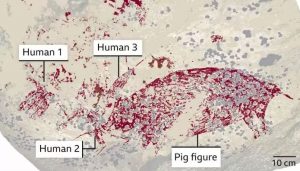Note4Students
From UPSC perspective, the following things are important :
Prelims level: About Leang Karampuang Cave
Mains level: Key features of the Cave Paintings

Why in the News?
- A cave painting discovered in the limestone cave of Leang Karampuang on Sulawesi Island, Indonesia, dates back at least 51,200 years.
- The painting features a scene with three part-human, part-animal figures interacting with a wild pig, depicted in red pigment.
Study Details:
Use of Uranium-based Dating:
|
About Leang Karampuang Cave
- Leang Karampuang Cave is situated in the Maros-Pangkep karst region of South Sulawesi, Indonesia.
- The cave is renowned for its ancient rock art and archaeological findings, providing insights into early human civilization in the region.
- It features some of the oldest known hand stencils and paintings of animals, believed to be created by early humans.
Key features of the Cave Paintings:
- A painted scene depicting humans interacting with a pig on the cave wall.
- The artwork features a pig standing upright alongside three smaller human-like figures, all painted in a single shade of dark red pigment.
- This painting predates the cave art found in El Castillo, Spain, dating back around 40,800 years ago, marking it as older than European cave paintings.
Significance of the Painting
- According to researchers, the figures in the painting depict dynamic action, suggesting a narrative or story being told.
-
- The discovery pushes back the origin of figurative art among Homo sapiens, indicating a rich history of storytelling through visual art in early human societies.
- While Neanderthals began cave markings earlier, around 75,000 years ago, these were primarily non-figurative.
- The Sulawesi cave art suggests an advanced cultural and artistic development among early humans, predating similar European art by millennia.
Contemporary Period in the Indian Subcontinent:
|
| PYQ:
[2017] The painting of Bodhisattva Padmapani is one of the most famous and oft-illustrated paintings at (a) Ajanta (b) Badami (c) Bagh (d) Ellora |
Get an IAS/IPS ranker as your 1: 1 personal mentor for UPSC 2024
